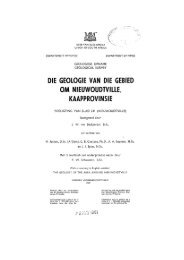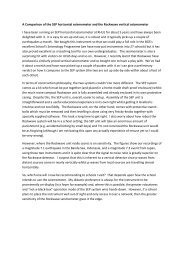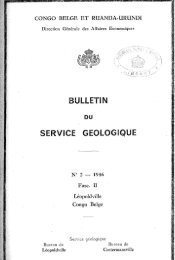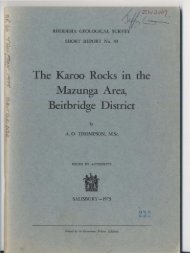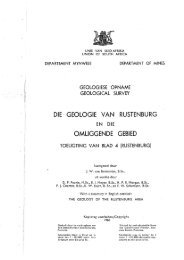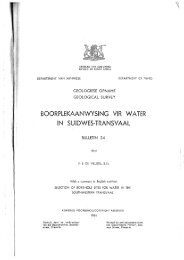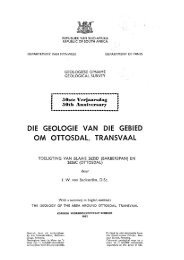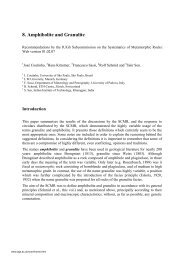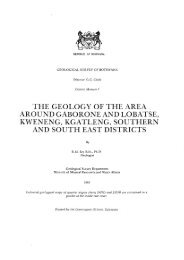Bibliography - British Geological Survey
Bibliography - British Geological Survey
Bibliography - British Geological Survey
You also want an ePaper? Increase the reach of your titles
YUMPU automatically turns print PDFs into web optimized ePapers that Google loves.
workmanship becomes cruder as we approach the commencement of the Pleistocene. The stones which have<br />
been wrought by man’s hand (Eoliths) become then more difficult to distinguish from those which have been<br />
shaped by natural forces.’ L. Rutot in Belgium claims he can trace an eolithic culture back beyond the<br />
Pleistocene into the Pliocene, Miocene and even into the Oligocene, which might be dated at 3 million years.<br />
The late Joseph Prestwich believed that the eoliths of Kent were of Pliocene age, yet many authorities reject<br />
eoliths as evidence of man’s handiwork. On the basis that anthropoid apes had appeared by the middle of the<br />
Miocene, Keith argues that primitive man could have evolved at the same period, or at the very latest during<br />
the early part of the Pliocene. In speaking of the evidence for early man in England he states that ‘It is a<br />
mystery why Neanderthal remains have not been discovered in England; they ought to be found, and a<br />
rumour is now current that they have been found.’ Keith had possibly heard rumour of the discoveries at<br />
Piltdown, but evidently had no details. He presented his paper on 9 Sept 1912.)<br />
[Keith, A.] 1913b. Piltdown: the most ancient skull in the world. The Sphere, 53 (18 Jan), 76. (This anonymous<br />
account of a visit to Piltdown, ‘where the most ancient skull in the world was found’, can be linked to<br />
an entry, dated Sunday 5 Jan 1913, in Keith’s personal diary. See Spencer 1990a, 190–191 etc, & Walsh<br />
1996, 153–155 etc, for quoted passages, discussion and differing interpretation.)<br />
Keith, A. 1913c. Problems relating to the teeth of the earlier forms of prehistoric man. Proceedings of the<br />
Royal Society of Medicine, 6 (odontol sect), 103‒124 (with discuss). (Piltdown mandible, pp. 116–119)<br />
Keith, A. 1913d. Present problems relating to the origin of modern races. Lancet, 2, 1050‒1053. (Piltdown<br />
man and other English finds)<br />
Keith, A. 1913e. Ape man or modern man? The two Piltdown skull reconstructions. Illustrated London<br />
News, 143, 16 & 23 Aug, 245, with 6 figs. (A criticism of Smith Woodward’s interpretation and restoration<br />
of the Piltdown skull)<br />
Keith, A. 1913f. Our most ancient relation. The Sphere, 53 (Sept), 811.<br />
Keith, A. 1913g (see Anon. 1913f)<br />
Keith, A. 1913h. The Piltdown skull and brain cast. Nature, 92 (16 Oct), 197‒199; (6 Nov), 292; (20 Nov),<br />
345‒346. (A criticism of Smith Woodward’s restoration, which prompted some heated exchanges with<br />
Elliot Smith; see Smith 1913c)<br />
Keith, A. 1914a. The significance of the discovery at Piltdown. Bedrock: A Quarterly Journal of Scientific<br />
Thought, 2 (Jan), 435‒453. (Considers that the remains found at Piltdown represent a form of man living in<br />
the later part of the Pliocene period; that speech was not possible with such a conformation of jaw and tongue;<br />
that, on the whole, the evidence is in favour of the mandible and skull being parts of one individual, but that<br />
the canine tooth belongs to another individual of the same race. He does not believe that Piltdown man is an<br />
ancestor of the modern races of mankind.)<br />
Keith, A. 1914b. The reconstruction of fossil human skulls. Journal of the Royal Anthropological Institute,<br />
44 (July), 12‒31. (Keith, by way of an experiment, set out to demonstrate the validity of his reconstruction<br />
of the Piltdown skull, which differs from that proposed by Woodward. As a practical test, he was furnished<br />
with some fragments of a specimen skull which he engaged to reconstruct using the same methodology that<br />
was applied to Piltdown. This was deemed, by Keith, to have been a success. Summarised in Nature, 29 Oct<br />
1914, p. 240. Keith devoted a whole chapter to this experiment in his Antiquity of Man, 1915.)<br />
Keith, A. Oct 1915. The antiquity of man. London: Williams and Norgate, xx, 519 pp; further impressions<br />
issued 1915, 1916 & 1920. (About a third of the book is devoted to a detailed consideration of Piltdown Man,<br />
thus: Ch. XVIII. The discovery of the Piltdown skull, pp. 293‒305; Ch. XIX. The antiquity of the Piltdown<br />
race, pp. 306‒315; Ch. XX. Eoanthropus dawsoni, pp. 316‒336; Ch. XXI. The difficulties of reconstruction,<br />
pp. 337‒355; Ch. XXII. An experiment in reconstruction, pp. 356‒375; Ch. XXIII. Heads–ancient and modern<br />
–in profile, pp. 376–396; Ch. XXIV. The brain of fossil man, pp. 397‒429; Ch. XXV. The Piltdown mandible,<br />
pp. 430‒452; Ch. XXVI. Evidence of the teeth of fossil man, pp. 453– 478; Ch. XXVII. The face of fossil<br />
man, pp. 479–496. Keith avoids the inclusion of any reconstructions showing how Eoanthropus might have<br />
appeared in life. See review by Woodward 1915b)<br />
Keith, A. 1916. [Obituary of Charles Dawson]. <strong>British</strong> Medical Journal.



